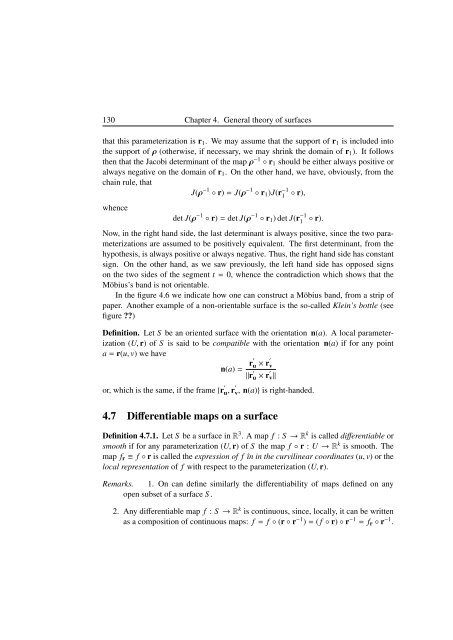Blaga P. Lectures on the differential geometry of - tiera.ru
Blaga P. Lectures on the differential geometry of - tiera.ru
Blaga P. Lectures on the differential geometry of - tiera.ru
Create successful ePaper yourself
Turn your PDF publications into a flip-book with our unique Google optimized e-Paper software.
130 Chapter 4. General <strong>the</strong>ory <strong>of</strong> surfaces<br />
that this parameterizati<strong>on</strong> is r1. We may assume that <strong>the</strong> support <strong>of</strong> r1 is included into<br />
<strong>the</strong> support <strong>of</strong> ρ (o<strong>the</strong>rwise, if necessary, we may shrink <strong>the</strong> domain <strong>of</strong> r1). It follows<br />
<strong>the</strong>n that <strong>the</strong> Jacobi determinant <strong>of</strong> <strong>the</strong> map ρ −1 ◦ r1 should be ei<strong>the</strong>r always positive or<br />
always negative <strong>on</strong> <strong>the</strong> domain <strong>of</strong> r1. On <strong>the</strong> o<strong>the</strong>r hand, we have, obviously, from <strong>the</strong><br />
chain <strong>ru</strong>le, that<br />
whence<br />
J(ρ −1 ◦ r) = J(ρ −1 ◦ r1)J(r −1<br />
1<br />
◦ r),<br />
det J(ρ −1 ◦ r) = det J(ρ −1 ◦ r1) det J(r −1<br />
1<br />
Now, in <strong>the</strong> right hand side, <strong>the</strong> last determinant is always positive, since <strong>the</strong> two parameterizati<strong>on</strong>s<br />
are assumed to be positively equivalent. The first determinant, from <strong>the</strong><br />
hypo<strong>the</strong>sis, is always positive or always negative. Thus, <strong>the</strong> right hand side has c<strong>on</strong>stant<br />
sign. On <strong>the</strong> o<strong>the</strong>r hand, as we saw previously, <strong>the</strong> left hand side has opposed signs<br />
<strong>on</strong> <strong>the</strong> two sides <strong>of</strong> <strong>the</strong> segment t = 0, whence <strong>the</strong> c<strong>on</strong>tradicti<strong>on</strong> which shows that <strong>the</strong><br />
Möbius’s band is not orientable.<br />
In <strong>the</strong> figure 4.6 we indicate how <strong>on</strong>e can c<strong>on</strong>st<strong>ru</strong>ct a Möbius band, from a strip <strong>of</strong><br />
paper. Ano<strong>the</strong>r example <strong>of</strong> a n<strong>on</strong>-orientable surface is <strong>the</strong> so-called Klein’s bottle (see<br />
figure ??)<br />
Definiti<strong>on</strong>. Let S be an oriented surface with <strong>the</strong> orientati<strong>on</strong> n(a). A local parameterizati<strong>on</strong><br />
(U, r) <strong>of</strong> S is said to be compatible with <strong>the</strong> orientati<strong>on</strong> n(a) if for any point<br />
a = r(u, v) we have<br />
n(a) = r′ u × r ′<br />
v<br />
�r ′<br />
u × r ′<br />
v�<br />
or, which is <strong>the</strong> same, if <strong>the</strong> frame {r ′<br />
u, r ′<br />
v, n(a)} is right-handed.<br />
4.7 Differentiable maps <strong>on</strong> a surface<br />
Definiti<strong>on</strong> 4.7.1. Let S be a surface in R 3 . A map f : S → R k is called differentiable or<br />
smooth if for any parameterizati<strong>on</strong> (U, r) <strong>of</strong> S <strong>the</strong> map f ◦ r : U → R k is smooth. The<br />
map fr ≡ f ◦ r is called <strong>the</strong> expressi<strong>on</strong> <strong>of</strong> f în in <strong>the</strong> curvilinear coordinates (u, v) or <strong>the</strong><br />
local representati<strong>on</strong> <strong>of</strong> f with respect to <strong>the</strong> parameterizati<strong>on</strong> (U, r).<br />
Remarks. 1. On can define similarly <strong>the</strong> differentiability <strong>of</strong> maps defined <strong>on</strong> any<br />
open subset <strong>of</strong> a surface S .<br />
◦ r).<br />
2. Any differentiable map f : S → R k is c<strong>on</strong>tinuous, since, locally, it can be written<br />
as a compositi<strong>on</strong> <strong>of</strong> c<strong>on</strong>tinuous maps: f = f ◦ (r ◦ r −1 ) = ( f ◦ r) ◦ r −1 = fr ◦ r −1 .












